How to grow pomegranate from seed at home?
The pomegranate tree symbolizes wealth, prosperity and is one of the favorite plants of flower growers. Growing it from a bone at home is an exciting and interesting activity. When proper care after a few years, you can get a beautiful bush. For sowing, varieties such as Dwarf, Baby, Carthage are ideal.
Indoor pomegranate is an unpretentious and grateful plant. If you create a comfortable environment for him, then he will delight not only with flowers, but also with fruits. They are not always edible, but how beautiful the green fluffy bush, hung with red balls, looks!
Selection and preparation of seeds
To grow indoor pomegranate from seed at home, you need to purchase seeds. You can find Baby or Carthage varieties in many specialty stores. You can combine the useful and the pleasant: collect the seeds from the pomegranate fruit. When buying a fruit on the market, you do not need to pay attention to the size and taste: hybrid varieties go on sale, which, when grown from seeds, do not receive the quality of the mother plant.
For seeds, choose a ripe fruit without rot, mold. Such a fruit will have a thin peel through which the grains can be easily felt. Ripe bones are hard when bitten. An empty seed inside is not suitable for sowing.
Preparing pomegranate seeds for sowing
- If the seeds are taken from the fruit, then the grains are pierced in several places with a needle, placed in a jar, covered with a lid and left for several days.
- After the bones are free from the pulp, they are washed with water, wiped and dried. It is necessary to ensure that they do not dry out and do not lose germination.
- To discard pomegranate seeds, they are soaked in a saline solution. For sowing, only those that first fell to the bottom are left.
- Before planting the seeds, wipe them with a nail file so that the sprout breaks through the thick skin faster.
- When buying seeds of the varieties Baby or Carthage in the store, it is worth treating the seeds in a solution of potassium permanganate in order to protect the plants from diseases
Preparing seeds for planting at home does not take much time, but all procedures must be done very carefully, because the quality of a houseplant depends on it.
Seedling care rules
The seeds in the soil are waiting for the hour when young borings will make their way to the light, but the grower should not relax: growing pomegranates is a laborious process. During this period, it is important to create optimal conditions for the rapid emergence of young shoots.
Features of planting pomegranate seeds
- A wide container with a height of 10 cm or more is selected.
- Expanded clay or gravel is used for drainage.
- The soil is bought at the store. High-moor peat or sand with 50/50 peat is best.
- The seeds are planted in moist soil to a depth of no more than 1 cm.
- After planting, the soil is compacted.
- The pot is covered with glass or foil - for quick emergence.
- The container is placed on a windowsill, if there is a working battery under it, or in another warm place.
- Airing is carried out once a day for several minutes.
During this period, heat and humidity play an important role. It is strictly forbidden to water the soil. When overdrying is allowed, the earth is sprayed from a spray bottle. If the seeds are viable, they will sprout within two months. Sometimes sprouts appear after six months, so you need to be patient.
Advice
For the emergence of quick shoots at home, pre-germination of seeds is practiced.The bones are soaked in a growth stimulator and wrapped in a damp towel or soaked in a saucer of warm water for 12-20 hours. The seeds must breathe. It is important that they do not dry out or be completely immersed in liquid. Without moisture, bones crack and die.
After the sprouts appear, the film is removed, and the seedlings are thinned out, removing weak plants. Only healthy, strong specimens are left. Several seedlings are later selected from them.
Plant care and bush formation
After the appearance of two or three leaves, the plants are transplanted into cups. The day before the procedure, the soil is watered. Remove the seedlings from a container with a clod of earth so as not to damage the root system. For transplantation, they take a fertile mixture for deciduous plants and do not forget about drainage in pots. The plant is buried in moist soil so that the root collar is buried by 1 cm. After planting, do not water it and put it in a greenhouse on a windowsill or under a lamp. In the early days, the greenhouse is shaded from light.
Important!
During this period, it is important to monitor the humidity: it is necessary to ventilate the seedlings several times a day. After the appearance of new leaves, plants are gradually accustomed to independent life.
Top dressing is applied when there is complete confidence that the seedlings have taken root. At the initial stage, nitrogen and potash fertilizers are used, later - complex fertilizing for fruit indoor plants. They are brought in no more than once a month during the period of active growth.
When the roots are wrapped in an earthen lump in a pot, the seedling is pinched and after a week it is transferred into a large container to a permanent place. Once every two months, the plant is pinched under the third pair of leaves and a bush of the desired shape is formed.
Important!
Indoor pomegranate is thermophilic and tolerates hot weather well at home, if a certain level of humidity is maintained. But the cold in the room can destroy it. At a temperature of +16, the plant sheds its leaves and goes into a passive phase. This means that growing bushes on an unheated balcony is unacceptable during the cold season.
Pomegranate bonsai
To form a bonsai from a pomegranate at home, you need to grow it with one branch. The top of the seedling is not pinched, but a single branch is tied to a wire so that it is straight and vertical. When the plant gets stronger, the height is adjusted.
Bonsai can be of different shapes; spiral, erect, curved with an inclination to the side. The crown of the pomegranate is made triangular, broom-shaped, round or spreading.
Indoor variety Baby can be shaped even in adulthood.
Growing bonsai in a traditional form is very popular with florists. A small tree with a thick trunk and spreading branches captures the gaze of every person. To get such a miracle at home, you need to make a lot of effort and spend several years, but believe me, it's worth it.
To grow indoor pomegranate from a stone at home is within the power of every florist. In order for the plant to please with lush flowering, you need to pay a little attention to it and learn as much as possible about how to properly care for young seedlings, learn the features of the formation of a bush and the rules for fertilizing in different periods of the year. Learn to talk with your green pet, and he himself will tell you what and when to do so that a lush pomegranate bush flaunts on the windowsill and pleases not only with bright flowers, but also with a rich harvest.
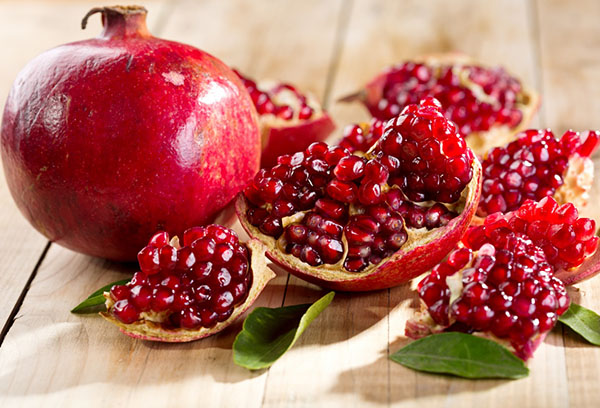
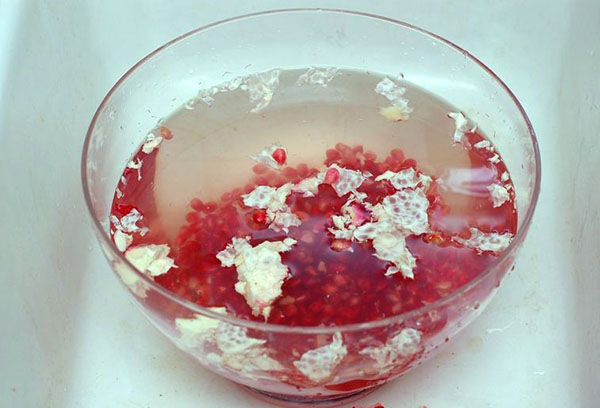
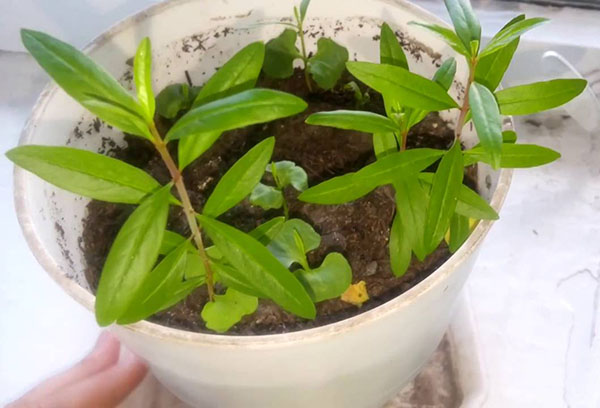
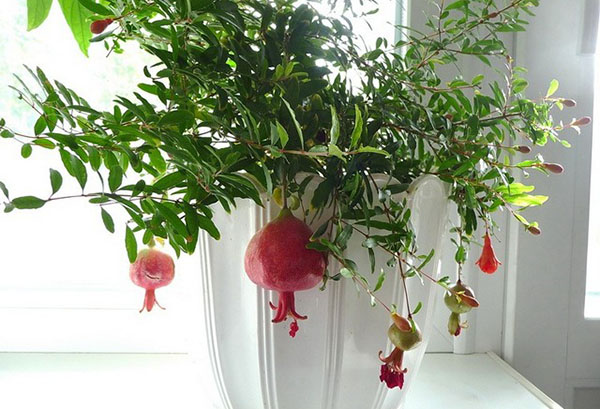
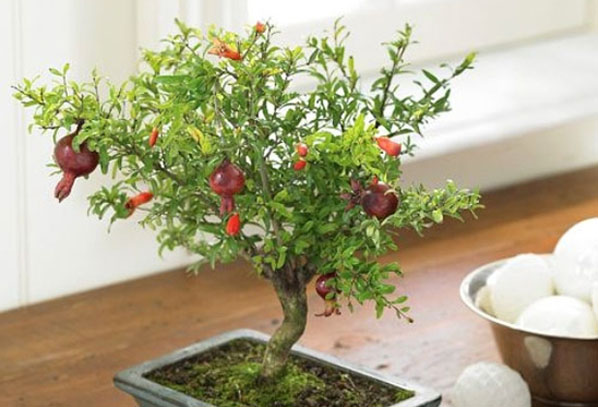
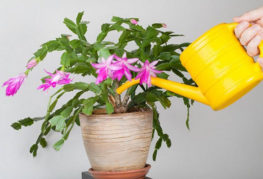
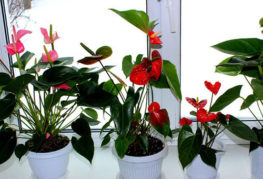

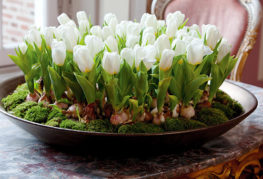
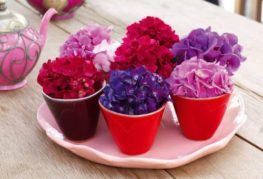
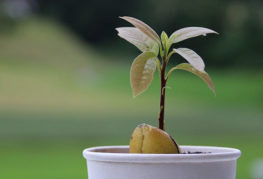
and will be published shortly.